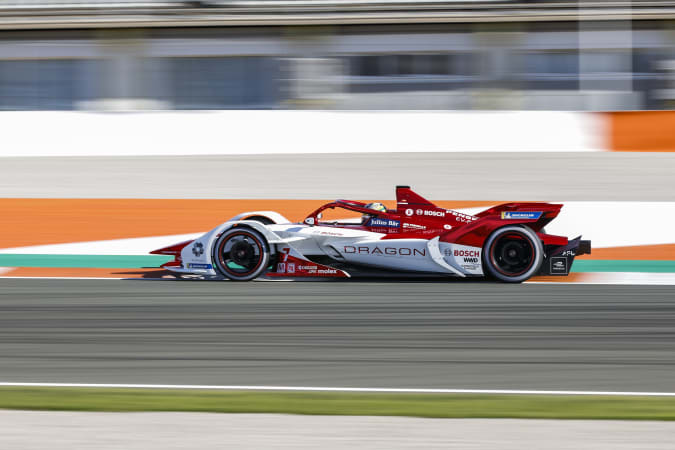Like millions of other people, I’ve been enthralled by Drive to Survive on Netflix which means I’m also newly obsessed with the world of Formula 1. I’m all in. I have the calendar reminders set. I watch all the practices if work permits. It has really become a thing, which means that since the season ended, there was a massive void in my sports viewing – save for the archive of F2 races on ESPN+. But watching a backlog of races is only so exciting when you’ve been following the sport and already know Oscar Piastri ran away with the title.
Enter Formula Ethe all-electric racing series that began in 2014 and is governed by the FIA, the same body that oversees F1. The first two rounds took place at the end of January in Saudi Arabia, offering two full E-Prix races in one weekend. I had never watched Formula E before that weekend, but I was so starved for racing I gave it a shot. Turns out, I’ve been missing a unique racing series full of entertaining quirks.
It’s a bit weird
You expect the cars to be different internally due to their electric power sources, but the overall design is also unique. Formula E got rid of the traditional rear wing in 2018, opting instead for a split wing construction. These cars also have front wheel fairings that reduce drag and turbulence that comes off the front tires. The combination of those two elements alone give Formula E cars a much different aesthetic than those in F1.
Qualifying is quite different in this series, too. Starting this season, there’s a Group stage with two sets of 11 drivers, ranked in order of the current Drivers’ World Championship position. They attempt to set the fastest lap time in a 10-minute session. The four fastest drivers from each group move on to the Duels stage. Here, eight drivers go head-to-head in a knockout style bracket with the winners progressing until one is left.
NurPhoto via Getty Images
The winner is awarded pole position, with the runner-up starting second, semi-finalists in third/fourth and the quarter finalists in fifth/sixth. Higher position goes to the faster lap time in those rounds. Remaining drivers from the polesitters group then fill in the odd positions on the grid and those from the other set start in the even spots. It sounds overly complicated, but the head-to-head matchups were fun to watch in Diriyah.
Then there’s a thing called Attack Mode, which has to have been designed by a gamer. During each race, a driver has to hit a certain area on the track that activates an additional 25 kW of power for a specified amount of time. That duration, as well as how many times the cars have to hit that spot during the E-Prix, are determined at each event. The catch is the Attack Mode area is out of the main racing line, so if someone is right on you, you may have to give up track position in order to fulfill your obligation. Plus, there’s a color changing ring around the halo on each car, so viewers know who has Attack Mode active.
Another interesting element is Fanboost. Here, viewers can have a direct impact on the race by voting for their favorite driver on social media. Voting starts a few days before the E-Prix and closes 15 minutes after the start. The top five drivers receive a five-second power boost that can be used during the second half of the race.
Races are quick
A friend of mine has a theory about European sports, and I think he’s spot on. You can watch an event, but individually they aren’t so long that one dominates the day (unless you watch several, of course). A soccer match is over in less than two hours, and Formula 1 races are about the same. Juxtapose that with the typical three-hour or longer NFL game or MLB matchup and you quickly see that folks in Europe are onto something.
NurPhoto via Getty Images
Formula 1 races have a time limit because the cars can’t be refueled during a race. Ditto for Formula E: the cars have a finite amount of power and when it’s gone, you can’t exactly charge them up during a pit stop. For that reason, the electrified series races, or E-Prix, are limited to 45 minutes. There’s no set number of laps, just a countdown clock that keeps teams abreast of how much time is left. Once that period is up, there’s one additional lap to the finish. Starting this season, officials can now add up to 10 additional minutes in the event of a safety car or full-course yellow during the main racing window.
USA! USA!
Unlike the current lineup of F1 drivers, there’s an American running in Formula E. New to the Avalanche Andretti team this season, Oliver Askew brings his IndyCar experience to the E-Prix circuits. When it comes to Americans within sniffing distance of an F1 car, Askew and Logan Sargeant, who currently races in F2 with Carlin, are the closest.
Who knows if I’ll keep up my new Formula E habit once F1 returns in March. There’s only one more E-Prix before a long break until April, and it’s this weekend in Mexico City. At the very least, I could see Formula E filling the void when there’s an off week between Grand Prix, which is exactly what it has done to get me through the final stages of the F1 offseason.
All products recommended by Engadget are selected by our editorial team, independent of our parent company. Some of our stories include affiliate links. If you buy something through one of these links, we may earn an affiliate commission.

